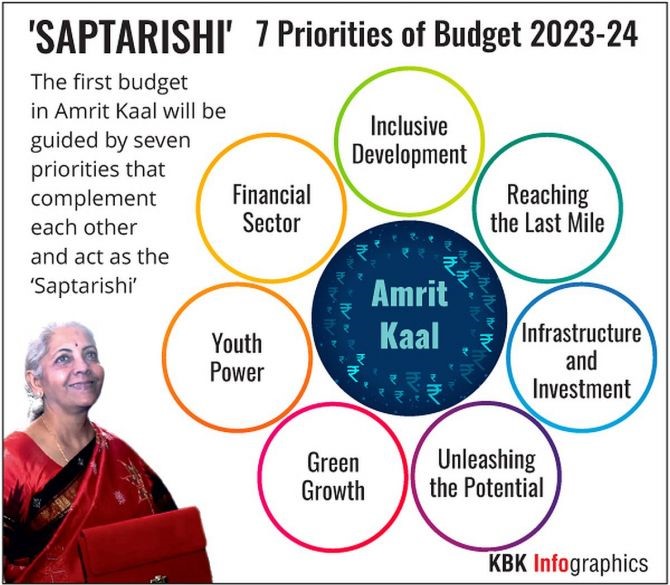SPOTLIGHT: Budget Webinar: Reaching the Last Mile

Disclaimer: Copyright infringement not intended.
Context
- The Prime Minister, Shri Narendra Modi, addressed a Budget Webinar on the subject of ‘Reaching the last mile’.
- Theme of the Webinar: Policy of saturation.
Highlights of PM Modi’s Address
- The more emphasis we put on Good Governance, the more easily our goal of reaching the last mile will be accomplished.
- He gave the example of new approaches in the immunization and vaccine coverage in Mission Indradhanush and Corona pandemic to illustrate the power of good governance in the last mile delivery.
- Explaining the thinking behind the policy of saturation, the Prime Minister said that the approach of reaching the last mile and saturation policy complement each other. He said as opposed to the earlier scenario when the poor were running after the government for basic facilities, now the government is reaching the doorstep of the poor.
“The day we decide that every basic facility will be provided to every citizen in every area, then we will see what a big change will come in the work culture at the local level. This is the spirit behind the policy of saturation.
- Giving examples of this approach, the Prime Minister cited PM SVANidhi Scheme that linked the street vendors to formal banking, Development and Welfare Board for De-notified, Nomadic and Semi-Nomadic Communities, 5 lakh common service centers in villages and milestone of 10 crore cases of tele-medicine.
- The Prime Minister said that this year’s Budget has paid special attention to taking the mantra of reaching the last mile to tribal and rural areas. He said that for this, thousands of crore rupees have been allocated to the Jal Jeevan Mission.
- He said that work has started on more than 60 thousand Amrit Sarovar, out of which 30 thousand Sarovars have already been constructed. These campaigns are improving the standard of living of those Indians living far and wide, who have been waiting for such facilities for decades.
- The Prime Minister asked the stakeholder to discuss the ways of linking housing with technology for finding ways of making strong but affordable houses, finding easy ways of benefiting from solar power and group housing models acceptable in both urban and rural areas.
- Referring to the robust allocations for the staffing of the Eklavya Residential Schools, the Prime Minister asked the gathering to see the feedback from the teachers and students from these schools and how students of these schools can get exposure of the big cities. He asked them to deliberate on the ways of creating more Atal Tinkering Labs in these schools and workshops for aspects related with startups.
- The Prime Minister also mentioned Pasmanda Muslims. A target has also been set in this budget to completely get rid of sickle cell.
- The Aspirational District Program has emerged as a successful model in terms of Reaching the Last Mile. Taking this approach further, an Aspirational Block programme is now being started in 500 blocks of the country.
Read:
Mission Indradhanush: https://www.iasgyan.in/daily-current-affairs/mission-indradhanush
PM SVANidhi Scheme : https://www.iasgyan.in/daily-current-affairs/pm-svanidhi-scheme-2
Telemedicine: https://www.iasgyan.in/daily-current-affairs/e-sanjeevani-10
Jal Jeevan Mission: https://www.iasgyan.in/daily-current-affairs/jal-jeevan-mission-49
Mission Amrit Sarovar: https://www.iasgyan.in/daily-current-affairs/amrit-sarovar
Eklavya Residential Schools:https://www.iasgyan.in/daily-current-affairs/eklavya-schools
Atal Tinkering Labs: https://www.iasgyan.in/blogs/atal-tinkering-labs-17
Pasmanda Muslims: https://www.iasgyan.in/daily-current-affairs/pasmanda-muslims#:~:text='Pasmanda'%20is%20a%20Persian%20word,Pasmanda%20as%20an%20umbrella%20identity
Aspirational District Program: https://www.iasgyan.in/daily-current-affairs/aspirational-district-programme-41

To provide a sharper focus to the objective of ‘reaching the last mile’, the government has formed the ministries of AYUSH, Fisheries, Animal Husbandry and Dairying, Skill Development, Jal Shakti and Cooperation.
|
Focus area
|
Measures announced
|
|
Aspirational Districts and Blocks Program
|
- Launched the Aspirational Blocks Program covering 500 blocks for saturation of essential government services across multiple domains such as health, nutrition, education, agriculture, water resources, financial inclusion, skill development, and basic infrastructure.
|
|
Pradhan Mantri PVTG Development Mission
|
- To improve socio-economic conditions of the particularly vulnerable tribal groups (PVTGs), Pradhan Mantri PVTG Development Mission will be launched.
- This will saturate PVTG families and habitations with basic facilities such as safe housing, clean drinking water and sanitation, improved access to education, health and nutrition, road and telecom connectivity, and sustainable livelihood opportunities.
- An amount of Rs 15,000 crore will be made available to implement the Mission in the next three years under the Development Action Plan for the Scheduled Tribes.
|
|
Eklavya Model Residential Schools
|
- In the next three years, centre will recruit 38,800 teachers and support staff for the 740 Eklavya Model Residential Schools, serving 3.5 lakh tribal students.
|
|
Water for Drought Prone Region
|
- In the drought prone central region of Karnataka, central assistance of Rs 5,300 crore will be given to Upper Bhadra Project to provide sustainable micro irrigation and filling up of surface tanks for drinking water.
|
|
PM Awas Yojana
|
- The outlay for PM Awas Yojana is being enhanced by 66% to over Rs 79,000 crore.
|
|
Bharat Shared Repository of Inscriptions (Bharat SHRI)
|
- ‘Bharat Shared Repository of Inscriptions’ will be set up in a digital epigraphy museum, with digitization of one lakh ancient inscriptions in the first stage.
|
|
Support for poor prisoners
|
- For poor persons who are in prisons and unable to afford the penalty or the bail amount, required financial support will be provided.
|
Areas That Need To Be Addressed To Ensure Last Mile Development In India
Unemployment
- The first condition that needs to be rectified is unemployment. Unemployment is a major issue in last mile areas in India.
- While agriculture and farming practices are regarded as the primary occupations of rural people in India, they also need additional job opportunities for sustenance and all-round development.
Education
- The root to a majority of problems in last mile areas is inadequate education.
- With the growth of education facilities individuals can get the basic literacy skills of reading, writing and arithmetic. Not just that, with better literacy skills, they would also have better abilities to take up a job or achieve employment.
- Education will also lead to awareness and people can step up with better decisions for themselves and their sustenance.
- Improvement in the schooling infrastructure in the remote areas of India will lead to sustainable growth and development of these areas in the near future. With better education, the future generations will have access to better financial resources which will lead to a better life and living conditions.
Health Care Facilities
- It is one of the key areas that need to be addressed and looked into while aiming for the growth and development of last mile areas.
- It is one of the basic responsibilities of the government and good health care facilities is something that is essential for development in India.
Final Thoughts
- The government needs to take proactive measures to lead to the development of last mile areas and the living conditions of rural people. Last Mile in India is possible and can be done when the right initiatives are taken for the development of the social, economic and living conditions of the people living in the region.
https://newsonair.gov.in/Spotlight.aspx#
https://www.indiainfoline.com/article/budget-highlights/union-budget-priority-reaching-the-last-mile-1675239399782_1.html
PRELIMS FOCUSSED NEWS ARTICLES
INTERNATIONAL ATOMIC ENERGY AGENCY (IAEA)
Context
- Sri Lanka’s Cabinet has given the nod to seek membership in two International Conventions for Nuclear damage.
- Membership in the conventions will be a step forward as per recommendations of the International Atomic Energy Agency (IAEA).
About
IAEA Missions:
- Peaceful uses:Promoting the peaceful uses of nuclear energy by its member states.
- Safeguards:Implementing safeguards to verify that nuclear energy is not used for military purposes.
- Nuclear safety: Promoting high standards for nuclear safety.
IAEA Functions:
- It researches use of atomic energy in other areas such as agriculture, industry and medicine.
- IAEA's plays crucial role in generating public awareness and supporting efforts to make nuclear power more affordable
- It advises its members about developing and operating nuclear power stations and disposing of radioactive waste.
- It played a big role in the Ukraine's Chernobyl nuclear power station disaster management.
- Its serve as scientifically credible institution for objective analysis, expert advice, standard setting, technology transfer, credible oversight and verification.
India and IAEA
- India is a founding member of IAEA.
- Presently, 26 Indian nuclear facilities are under this international nuclear energy watchdog.
- India is actively contributing to the work of IAEA and assisting other countries in developing aspects of nuclear science.
https://newsonair.gov.in/News?title=Sri-Lanka%e2%80%99s-Cabinet-gives-nod-to-seek-membership-in-two-International-Conventions-for-Nuclear-damage&id=456649
.jpeg)
MAP OF ANTARCTICA
Context
- The Antarctic sea ice shrunk to a record low- Reports.

RAISINA DIALOGUE
Context
- The 8th Edition of the Raisina Dialogue will continue till 4th March in New Delhi.
Theme
- The theme of the 2023 Edition of Dialogue is "Provocation, Uncertainty, Turbulence: Lighthouse in the Tempest.
Details
- The Raisina Dialogue 2023 will witness the participation of representatives from over 100 countries including Ministers, Military Commanders, Captains of the Industry, Technology Leaders, Scholars on Strategic Affairs, Experts from leading Think Tanks and Youth. This year’s edition assumes special significance coming against the backdrop of India’s G20 Presidency.
About Raisina Dialogue
- The Raisina Dialogue is a multilateral conference held annually in New Delhi, India. Since its inception in 2016, the conference has emerged as India's flagship conference on geopolitics and geo-economics. The conference is hosted by the Observer Research Foundation, an independent think tank, in collaboration with the Ministry of External Affairs of India.
- The conference is structured as a multi-stakeholder, cross-sectoral discussion, involving a variety of global policymakers including heads of states, cabinet ministers and local government officials. In addition, the Dialogue also welcomes major private sector executives, as well as members of the media and academia. It is designed on the lines of Singapore's Shangri-La Dialogue.
- The name "Raisina Dialogue" comes from Raisina Hill, an elevation in New Delhi, seat of the Government of India, as well as the Presidential Palace of India, Rashtrapati Bhavan.
https://newsonair.gov.in/News?title=India%e2%80%99s-flagship-conference-on-geopolitics-and-geo-strategy%2c-Raisina-Dialogue-to-be-inaugurated-by-PM-Modi-on-Thursday&id=456632

WORLD RADIO DAY
Context
- World Radio Day was celebrated across the globe.
About
- World Radio Day is an international daycelebrated on 13 February each year.
- The Day was decided by UNESCOon 3 November 2011 during its 36th conference.
Details
- The day is observed every year to raise awareness among the public and the media about the importance of radio and to encourage access to information through radio.
- The theme for the 12th edition of World Radio Day is 'Radio and Peace'.
- On this occasion, a two-day Radio Festival with the theme : 'Radio for Peace and Radio for Climate Action', is being celebrated in New Delhi.
https://newsonair.gov.in/News?title=World-Radio-Day-being-celebrated-across-the-globe-today&id=455701







